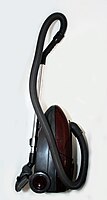
Photo from wikipedia
Evaluation of the health effects of particulate matter with aerodynamic dias. ≤ 2.5 μm (PM2.5) should reflect realistic condition in ambient atmosphere. However, using conventional filtration methods, only extracts from… Click to show full abstract
Evaluation of the health effects of particulate matter with aerodynamic dias. ≤ 2.5 μm (PM2.5) should reflect realistic condition in ambient atmosphere. However, using conventional filtration methods, only extracts from PM2.5 collected on the filter can be analyzed and not the particle itself. Cyclonic separation is a technique that enables the direct analysis of the effects of the crude "powder form" of PM2.5 on respiratory health. Airway epithelial cells and antigen-presenting cells were exposed to PM2.5 collected during the same period using a conventional filtration method or cyclonic separation. PM2.5 collected using cyclonic separation led to a higher secretion of interleukins 6 and 8 (IL-6, IL-8) from airway epithelial cells, and IL-6, IL-1β, tumor necrosis factor-α (TNF-α) secretion, cluster of differentiation 86 (CD86), and dendritic and epithelial cells 205 (DEC205) expression on antigen-presenting cells, compared with the effects of filter-collected PM2.5. Furthermore, PM2.5 collected using cyclonic separation increased inflammatory cytokine levels and induced lung inflammation in vivo. These results suggest that crude PM2.5 collected using cyclonic separation causes stronger biological responses than filter-collected PM2.5. Hence, PM2.5 collected using cyclonic separation can be utilized for a reliable evaluation of the health effects of ambient PM2.5.
Journal Title: Environmental research
Year Published: 2020
Link to full text (if available)
Share on Social Media: Sign Up to like & get
recommendations!